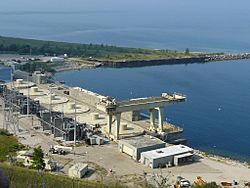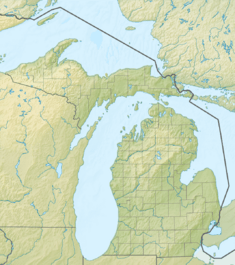Ludington Pumped Storage Power Plant facts for kids
Quick facts for kids Ludington Pumped Storage Plant |
|
|---|---|
 |
|
|
Location of Ludington Pumped Storage Plant in Michigan
|
|
| Country | United States |
| Location | Ludington, Michigan |
| Coordinates | 43°53′37″N 86°26′43″W / 43.89361°N 86.44528°W |
| Purpose | Power |
| Status | Operational |
| Construction began | July, 1968 |
| Opening date | 1973 |
| Construction cost | $327 million (1973) |
| Owner(s) | Consumers Energy (51%) Detroit Edison (49%) |
| Dam and spillways | |
| Type of dam | Embankment dam |
| Height (foundation) | 103 feet (31 m) |
| Length | 6 miles (9.7 km) |
| Width (crest) | 21 feet (6.4 m) |
| Reservoir | |
| Total capacity | 82,860 acre-feet (102,210,000 m3) |
| Active capacity | 52,171 acre-feet (64,352,000 m3) |
| Inactive capacity | 30,689 acre-feet (37,854,000 m3) |
| Surface area | 842 acres (341 ha) |
| Maximum length | 2.5 miles (4.0 km) |
| Maximum width | 1 mile (1.6 km) |
| Maximum water depth | 110 feet (34 m) |
| Power station | |
| Name | Power Station |
| Coordinates | 43°53′37″N 86°26′43″W / 43.89361°N 86.44528°W |
| Commission date | 1973 |
| Type | Pumped-storage |
| Hydraulic head | 363 feet (111 m) |
| Installed capacity | 2,172 MW |
| Annual generation | -752 |
The Ludington Pumped Storage Plant is a special kind of hydroelectric power plant and a large reservoir in Ludington, Michigan. It was built between 1969 and 1973. When it was finished, it was the biggest pumped storage power plant in the world! It is owned by two companies, Consumers Energy and DTE Energy.
Contents
How the Plant Works
The Big Reservoir
The plant has a huge reservoir, which is like a giant lake built by people. This reservoir is about 33 meters (110 feet) deep. It stretches for about 4 kilometers (2.5 miles) long and 1.6 kilometers (1 mile) wide. It can hold a massive amount of water, about 314 billion liters (82,859 acre-feet)!
This large reservoir sits right next to Lake Michigan. Because the ground underneath wasn't strong enough to hold all that water, engineers had to line the bottom of the reservoir. They used layers of asphalt and clay to make sure water wouldn't leak into the ground.
Power Generation and Pumping
The power plant has six special machines called reversible turbines. These turbines can do two jobs:
- Generate electricity: When people need a lot of power, water from the upper reservoir rushes down through huge pipes called penstocks. These pipes are about 335 meters (1,100 feet) long. The rushing water spins the turbines, which creates electricity. Each turbine can make 312 megawatts of power, for a total of 1,872 megawatts! The plant can start making electricity in just two minutes.
- Pump water uphill: When there isn't much demand for electricity, like at night, the turbines work in reverse. They use electricity from the power grid to pump water from Lake Michigan back up into the reservoir. This water is lifted about 110 meters (363 feet) uphill.
This system uses the natural steep sand dunes along Lake Michigan. It's like a giant battery! The plant stores energy by pumping water uphill when electricity is cheap. Then, it releases the water to make power when electricity is needed most. This helps balance the power grid and reduces the need for other power plants that only run during peak times.
The Ludington Pumped Storage Plant is connected to six large power lines. These lines help send the electricity to homes and businesses. In 1973, this project won an award for "Outstanding Civil Engineering Achievement."
Plant Upgrades
In 2008, the owners of the plant started talking about making it even better. They wanted to make the plant last longer and work more efficiently. They also thought about using wind power from wind farms along Lake Michigan.
Wind power can be tricky because the wind doesn't always blow when electricity is needed. Pumped storage plants like Ludington are perfect for this! They can store extra wind energy by pumping water uphill. Then, they can release it when the wind isn't blowing and people need power.
In 2011, Consumers Energy and Detroit Edison announced a big upgrade project. It cost $800 million and started in 2013. The plan was to replace all six of the plant's turbines. This would make the plant last another 40 years! It would also increase its power output from 1,872 megawatts to 2,172 megawatts. This means it could power even more homes.
By August 2020, five of the six turbines had been replaced. The whole project was expected to be finished by mid-2021.
Images for kids



